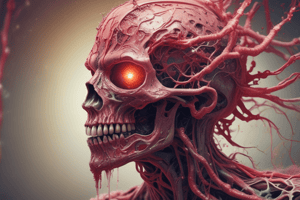Podcast
Questions and Answers
How do pathogens typically cause disease when transmitted from an infected to a healthy person?
How do pathogens typically cause disease when transmitted from an infected to a healthy person?
- By immediately strengthening the immune system of the healthy person.
- By directly providing essential nutrients to the healthy person, disrupting their natural balance.
- By remaining dormant in the healthy person's body without causing any immediate harm.
- By multiplying and disrupting normal bodily functions in the healthy person. (correct)
Which action is most effective in preventing the transmission of pathogens through the air?
Which action is most effective in preventing the transmission of pathogens through the air?
- Consuming large amounts of vitamin C supplements daily.
- Avoiding contact with individuals who cough or sneeze.
- Ensuring proper ventilation and covering mouth and nose when coughing or sneezing. (correct)
- Using hand sanitizer with high alcohol content after touching surfaces.
How can food become contaminated with microbes, leading to illness?
How can food become contaminated with microbes, leading to illness?
- Through packaging materials that introduce beneficial microbes to the food.
- Through proper refrigeration that alters the food's natural state.
- Through cooking methods that enhance microbial growth, such as slow cooking.
- Through exposure to vectors such as flies or by being contaminated during processing. (correct)
How do open wounds increase the risk of microbial infection?
How do open wounds increase the risk of microbial infection?
How do insects like mosquitoes contribute to the transmission of diseases?
How do insects like mosquitoes contribute to the transmission of diseases?
What roles do microorganisms play in food production?
What roles do microorganisms play in food production?
Under what circumstances can normally harmless microorganisms become pathogenic?
Under what circumstances can normally harmless microorganisms become pathogenic?
What is the primary reason for using antiseptics on open wounds?
What is the primary reason for using antiseptics on open wounds?
What is the term for insects that transmit diseases from infected individuals to healthy ones, and how can the risk of transmission be minimized?
What is the term for insects that transmit diseases from infected individuals to healthy ones, and how can the risk of transmission be minimized?
Which process describes how pathogens spread from an infected person to a healthy person?
Which process describes how pathogens spread from an infected person to a healthy person?
Flashcards
What are pathogens?
What are pathogens?
Disease-causing microbes.
How do pathogens spread through the air?
How do pathogens spread through the air?
When an infected person coughs or sneezes, pathogens spread through tiny droplets.
What is spoiled food?
What is spoiled food?
Food contaminated by microbes through air or vectors like flies.
How do open wounds transmit microbes?
How do open wounds transmit microbes?
Signup and view all the flashcards
What are insect vectors?
What are insect vectors?
Signup and view all the flashcards
What is pathogen transmission?
What is pathogen transmission?
Signup and view all the flashcards
What is grape juice fermentation?
What is grape juice fermentation?
Signup and view all the flashcards
What is yeast?
What is yeast?
Signup and view all the flashcards
Study Notes
- Disease-causing microbes are known as pathogens.
- A large number of pathogens from a sick person can infect a healthy person through transmission.
- Pathogens enter bodies through different means.
Transmission Through Air
- When infected individuals cough or sneeze, pathogens from their body are released.
- Pathogens exit the body through tiny droplets of saliva or mucus.
- Airborne germs travel and can infect healthy individuals when they breathe them in.
- Germs can stick to hands or surfaces and then get into the body.
Transmission Through Spoiled Food
- Microbes contaminate food directly or via vectors like flies.
- Flies carry germs and transfer them to food.
- Foods like meat or fish may already contain microbes while the animal is alive.
- Eating raw food can cause diseases like Salmonella or food poisoning.
Transmission Through Open Wounds
- Open wounds are an easy entry point for microbes.
- Injuries from rusty nails or dirty objects can introduce deadly microbes like tetanus.
- Washing wounds, using plasters, applying alcohol or antiseptics minimizes exposure to pathogens.
Transmission Through Insect Bites
- Insects like mosquitoes and flies are vectors.
- Mosquito bites transmit diseases dengue and malaria from infected to healthy people.
- Insect repellents can minimize the risk of infection.
Studying That Suits You
Use AI to generate personalized quizzes and flashcards to suit your learning preferences.





